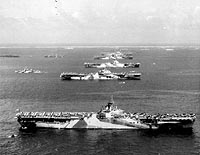
USS Wasp, a 27,100-ton Essex class aircraft carrier built at Quincy, Massachusetts, was commissioned on 24 November 1943. She arrived in the Pacific in March 1944 and conducted her first combat operations in May. During June-August, Wasp participated in the Marianas Campaign, including the Battle of the Philippine Sea, and in strikes elsewhere in the central Pacific. These were followed by support for the September assault on the Palaus, and, in October, by attacks on Okinawa, Formosa and the Philippines, and in the Battle of Leyte Gulf.
For the rest of 1944 and into January 1945, Wasp sent her planes against the Japanese in the Philippines, the South China Sea area and as far north as the Ryukyus. In February and March, she supported the Iwo Jima invasion and took part in raids on the Japanese Home Islands. While off Japan on 19 March 1945, Wasp received a bomb hit that caused heavy casualties among her crew, though she remained in action for several more days before steaming to the U.S. for repairs.
Wasp arrived back in the western Pacific in July 1945, in time to participate in the War's final air attacks on Japan. After the enemy capitulated in mid-August, she supported occupation efforts, despite suffering serious typhoon damage to her forward flight deck on 25 August. The carrier returned to the U.S. in October, then transported service personnel home before decommissioning in February 1947.
In mid-1948, Wasp began modernization to permit safer operation of heavier modern aircraft. After recommissioning in September 1951, she joined the Atlantic Fleet. On 26 April 1952, while en route to Gibraltar, Wasp collided with and sank the destroyer minesweeper Hobson, necessitating a return to the U.S. for repairs to her mangled bow. In mid-year, she deployed to the Mediterranean and Northern Europe. The ship was redesignated CVA-18 in October. Transferred to the Pacific in September 1953, Wasp deployed twice to Asian waters in 1953-55, received an angled flight deck and "hurricane" bow modernization, then made another western Pacific cruise in 1956.
In November 1956, Wasp became an anti-submarine warfare support aircraft carrier, with hull number CVS-18, and moved back to the Atlantic in early 1957. For more than a decade and a half, she kept busy on ASW, training and other operations in the Caribbean and Atlantic, visiting Northern Europe and the Mediterranean frequently. During 1965-66, Wasp also served as recovery ship for five manned space flights. The veteran carrier participated in her final exercises in the fall of 1971, then began preparations for inactivation. USS Wasp decommissioned in July 1972 and was sold for scrapping the following May.
This page features selected views concerning USS Wasp (CV/CVA/CVS-18).
| If you want higher resolution reproductions than the digital images presented here, see: "How to Obtain Photographic Reproductions." |
Click on the small photograph to prompt a larger view of the same image.
|
Photo #: 80-G-221142 USS Wasp (CV-18) Underway at sea in the vicinity of Trinidad, with planes parked forward, apparently in preparation for landing aircraft, 22 February 1944. Official U.S. Navy Photograph, now in the collections of the National Archives. Online Image: 89KB; 740 x 595 pixels Reproductions of this image may also be available through the National Archives photographic reproduction system. |
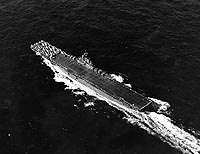 |
|
Photo #: 80-G-294131 "Murderers' Row" Third Fleet aircraft carriers at anchor in Ulithi Atoll, 8 December 1944, during a break from operations in the Philippines area. The carriers are (from front to back): USS Wasp (CV-18), USS Yorktown (CV-10), USS Hornet (CV-12), USS Hancock (CV-19) and USS Ticonderoga (CV-14). Wasp, Yorktown and Ticonderoga are all painted in camouflage Measure 33, Design 10a. Photographed from a USS Ticonderoga plane. Official U.S. Navy Photograph, now in the collections of the National Archives. Online Image: 78KB; 740 x 600 pixels Reproductions of this image may also be available through the National Archives photographic reproduction system. |
 |
|
Photo #: 80-G-261904 USS Wasp (CV-18) At sea in the western Pacific, 6 August 1945. Official U.S. Navy Photograph, now in the collections of the National Archives. Online Image: 112KB; 740 x 545 pixels Reproductions of this image may also be available through the National Archives photographic reproduction system. |
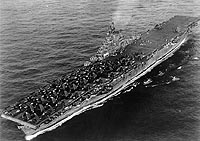 |
|
Photo #: NH 97508 USS Wasp (CVA-18) At sea in the Far East, 5 January 1955, at the time of the Tachen Islands evacuation. Official U.S. Navy Photograph, from the collections of the Naval Historical Center. Online Image: 121KB; 595 x 765 pixels |
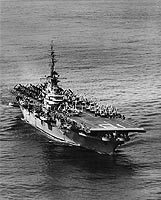 |
|
Photo #: NH 97509 USS Wasp (CVS-18) Underway, circa early 1967. This photograph was included with a 11 February 1967 USS Wasp press release, concerning her appearance at New Orleans' Mardi Gras festivities. Official U.S. Navy Photograph, from the collections of the Naval Historical Center. Online Image: 115KB; 740 x 610 pixels |
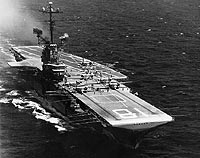 |
|
Photo #: NH 97510 USS Wasp (CVS-18) At sea in the Atlantic, with two SH-3 "Sea King" helicopters flying by in the foreground, 9 May 1969. Photographed by Ph2 Stabe. Official U.S. Navy Photograph, from the collections of the Naval Historical Center. Online Image: 77KB; 740 x 600 pixels |
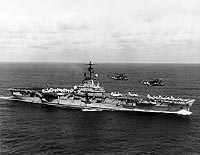 |
|
Photo #: 80-G-298609 USS Wasp (CV-18) Flight deck crews prepare to load a Mark XIII torpedo on a TBM aircraft, during strikes in the Luzon-Formosa area, 13 October 1944. Note plywood shrouds on the torpedo's fins and nose. Plane at right is an F6F, others visible are TBMs. Official U.S. Navy Photograph, now in the collections of the National Archives. Online Image: 89KB; 740 x 595 pixels Reproductions of this image may also be available through the National Archives photographic reproduction system. |
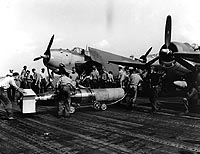 |
|
Photo #: 80-G-455702 Carrier Operations off Japan, August 1945 (right) A Japanese aircraft is shot down just off the starboard bow of USS Wasp (CV-18), during operations off Honshu, Japan, 9 August 1945. Two Fletcher class destroyers are in the foreground. Photographed from USS Bon Homme Richard (CV-31), the image includes two frames, showing the scene just before and after the crash. The original caption identifies the aircraft as a "Grace" (Aichi B7A2). Official U.S. Navy Photograph, now in the collections of the National Archives. Online Image: 94KB; 740 x 600 pixels Reproductions of this image may also be available through the National Archives photographic reproduction system. |
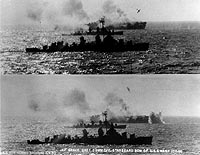 |
|
Photo #: USN 1057640 USS Wasp (CVS-18) In formation with destroyers and aircraft of Anti-submarine Task Group Bravo, in the Mediterranean Sea, 19 August 1961. All escorts are Gearing class DDEs. Planes overhead include ten S2F and two AD-5Ws. Two HSS-1 helicopters are flying just above the ships. Official U.S. Navy Photograph. Online Image: 79KB; 740 x 610 pixels Reproductions of this image may also be available through the National Archives photographic reproduction system as Photo # 428-N-1057640. |
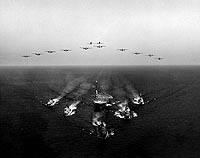 |
|
Photo #: NH 97511 Gemini IV Space Flight, June 1965 The Gemini IV space capsule is lifted aboard USS Wasp (CVS-18) on 7 June 1965, after completing a 62 revolution flight around the Earth in 97 hours and 56 minutes. The spacecraft, crewed by Astronauts James A. McDivitt and Edward H. White, landed about 48 miles short of its target and some 400 miles east of Cape Kennedy, Florida, at 12:12 PM Eastern Standard Time on 7 June. The National Aeronautics and Space Administration Gemini IV mission covered over 1,600,000 miles in the longest multimanned space flight yet flown. Caption information comes from the original NASA caption. Official National Aeronautics and Space Administration Photograph, from the collections of the Naval Historical Center. Online Image: 89KB; 740 x 600 pixels |
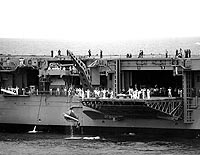 |
|
Photo #: 80-G-K-14048 (Color) USS Wasp (CV-18) Ready for launching, at the Bethlehem Steel Company shipyard, Quincy, Massachusetts, 17 August 1943. Official U.S. Navy Photograph, now in the collections of the National Archives. Online Image: 107KB; 585 x 765 pixels Reproductions of this image may also be available through the National Archives photographic reproduction system. |
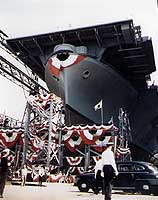 |
| If you want higher resolution reproductions than the digital images presented here, see: "How to Obtain Photographic Reproductions." |
Page made 9 March 2001
Caption corrected and coding updated 8 June 2006